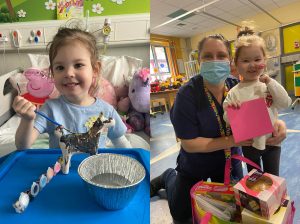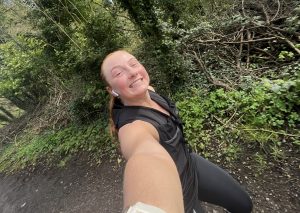
Group of Thirty Walkers Prepare for Willow’s Walk This Weekend
Willow was diagnosed with ALL in March 2023, so parents Craig, Jess and 30 other walkers will complete a symbolic fundraising walk
Professor Charles Craddock believes in the power of art.
He has seen, and experienced personally, how art and music can provide solace through difficult times and a context for the big questions in life.
He deals with life and death every day, as one of the world’s leading lights in haemato-oncology, or the treatment of blood cancers. He was recently awarded a CBE for services to medicine.
‘Both music and art can provide enormous solace to both patients and their clinicians,’ he says. ‘Working at the frontline, it’s not always easy looking after patients who are going through such difficult treatments. Although I am constantly inspired by their bravery, the outcome is not always what we hoped for.
‘Over the years, I have found music and painting an endless source of inspiration and reflection. Art and music contain certain universal truths.’
Prof Craddock is the co-founder of Cure Leukaemia, a partner and beneficiary of this year’s RBSA Charity Auction and one of Deutsche Bank’s UK Charities of the Year.
He is Academic Director of the world-renowned Centre for Clinical Haematology at the Queen Elizabeth Hospital, Birmingham, and Chair of the UK Stem Cell Strategic Oversight Committee. He also led the development of the £24 million Birmingham Institute of Translational Medicine.
‘This is an exciting time for developing new treatments for people with blood cancers – brutal diseases where progress has in the past been too slow and the outcome is still poor, especially for adults.
‘We are now seeing a remarkable revolution, a veritable tsunami in new drug, cell, and transplant therapies developed on the back of 60 years of brilliant science going all the way back to the discovery of DNA.
‘Using amazing advances in our understanding of the biology of diseases means we can develop more effective treatments, and we can also develop networks that connect patients.’
Lynn Jeffrey RBSA QE Entrance
Professor Craddock is behind a pioneering UK stem cell transplant trials network called IMPACT, launched in 2017.
‘For many people the only cure for blood cancer is a stem cell transplant. We know that 50 per cent of patients will die due to transplant failure or the disease returning.
‘The best way to improve patient outcomes is through clinical trials and yet currently, only five per cent of patients enter prospective transplant trials. The goal of IMPACT is to create a trials infrastructure so that the UK can deliver practice-changing studies.’
IMPACT is one of only two such networks in the world, and means that patients are able to access drugs they would otherwise be denied.
‘We are constantly told there needs to be evidence, but of course you have to create the evidence in the first place,’ Professor Craddock explains.
‘It’s no good drugs just sitting on shelves in laboratories. It can take up to a decade for a new drug to move from trials to reporting results and finally being approved. We’ve shown you can open a trial more quickly and return results sooner.’
One of the paintings in the auction is a signed Robert Plant portrait by Louise Cobbold
Awareness-raising through events like the RBSA Charity Auction and partnering with Deutsche Bank is crucial for generating public support for the work of Cure Leukaemia, Professor Craddock says.
‘We have to invest in networks that allow patients access to new treatments, and so it is vitally important to raise awareness. There is a great untapped potential in the general public to be excited by the amazing technological advances these therapies represent. Some of the new treatments which are transforming outcomes in specific cancers, in fact, have cost more to develop than it cost to put a man on the moon.
‘As a global community we have invested trillions of pounds in understanding the biology of disease and it is vital that we now ensure patients and their families see a return on the collective investment they have made over the last sixty years.’
Wayne Attwood VPRBSA ‘Birmingham Cathedral’
And the role of art has its place, too.
‘It’s fundamental,’ Professor Craddock says. ‘When we set up the Centre for Clinical Haematology in 2005, we worked with patients because the built environment is such a powerful statement.
‘We commissioned work by local artists who had an understanding of our patients and the work that we do, and as a result our waiting area is a much more humane and welcoming place.
‘Patients go through long and arduous courses of treatment, and we should use art and music to greater effect, as a creative way of connecting with people.
‘Our patients often say how they love the art on the walls. It’s calming, plus a reminder of the eternal verities of life and what is worth living for.
‘Our patients fight for life, and one of the reasons they fight so hard is that there are these fundamental truths encapsulated in art, truths that speak to why we are here on this earth.
‘Art can also lift the atmosphere and bring some humour and lightness, too.
‘Music and paintings all help you access a simple, spiritual space, reflecting the elegant simplicity of what lies at the heart of really good clinical medicine.’

Willow was diagnosed with ALL in March 2023, so parents Craig, Jess and 30 other walkers will complete a symbolic fundraising walk

Faye will be tackling her first ever marathon as she prepares for the UK's second largest marathon